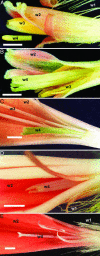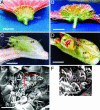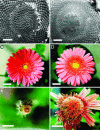Integration of reproductive meristem fates by a SEPALLATA-like MADS-box gene
- PMID: 15505223
- PMCID: PMC524820
- DOI: 10.1073/pnas.0406844101
Integration of reproductive meristem fates by a SEPALLATA-like MADS-box gene
Abstract
Reproductive transition, inflorescence architecture, meristem patterning, and floral organ identity have been studied as distinct research areas in plant science. By using the ornamental plant Gerbera, we demonstrate that all of these keystone aspects of reproductive meristematic fate are integrated genetically by a single SEPALLATA-like MADS-box gene from a functional class designated previously as "floral homeotic" or "organ identity." This extended regulatory network has not been elaborated in the model plant systems, which have a floral design and inflorescence-determinacy state that obscures these relationships.
Figures






References
-
- Battey, N. H. & Lyndon, R. F. (1990) Bot. Rev. 56, 162-189.
-
- Leyser, O. & Day, S. (2003) Mechanisms in Plant Development (Blackwell, Oxford).
-
- Pelaz, S., Ditta, G. S., Baumann, E., Wisman, E. & Yanofsky, M. F. (2000) Nature 405, 200-203. - PubMed
Publication types
MeSH terms
Substances
Associated data
- Actions
LinkOut - more resources
Full Text Sources
Other Literature Sources

